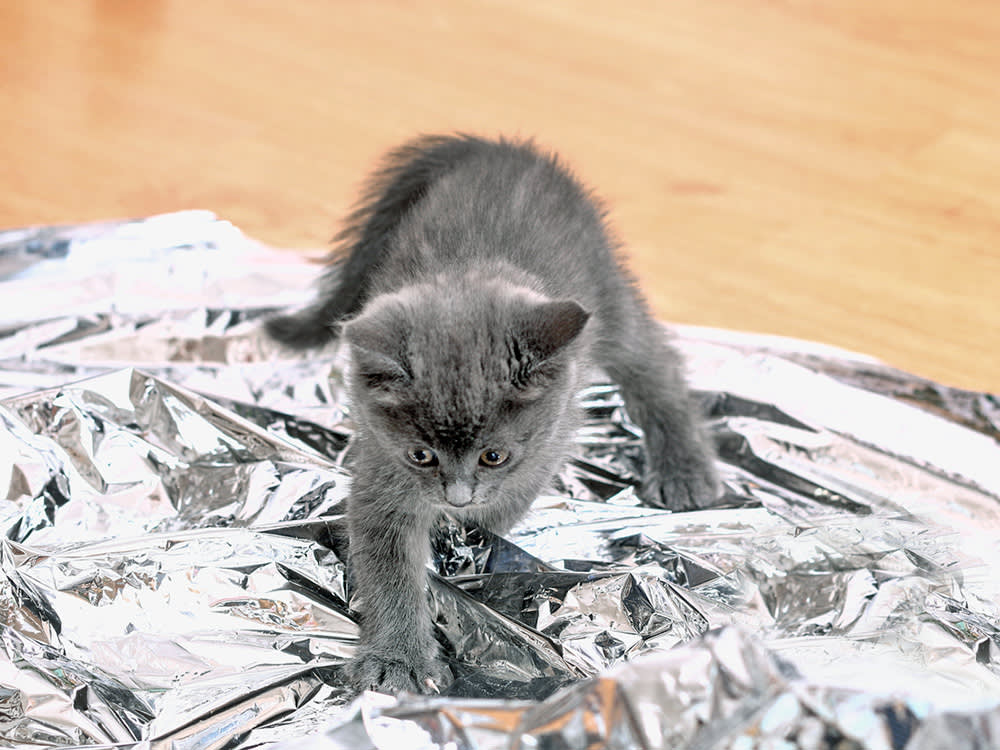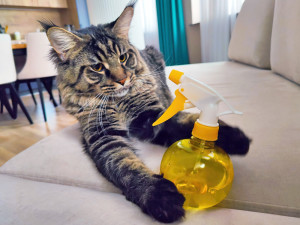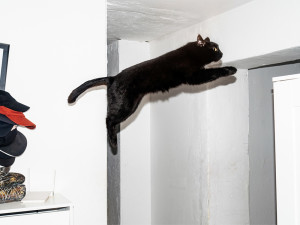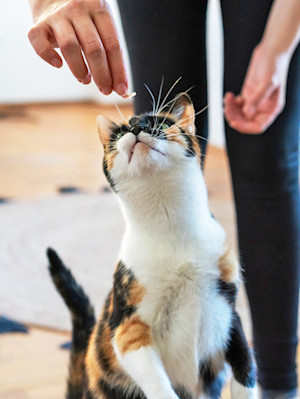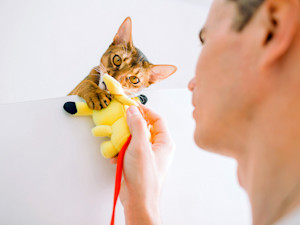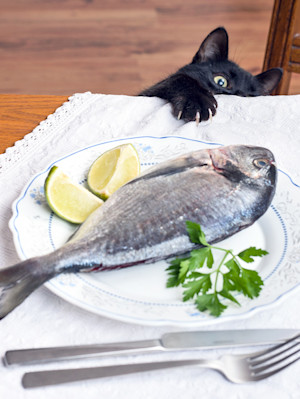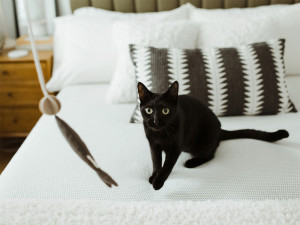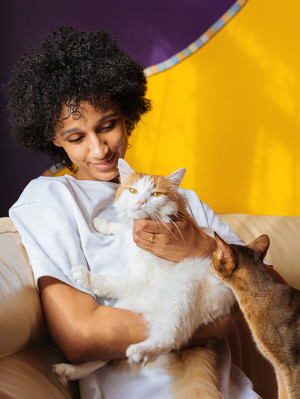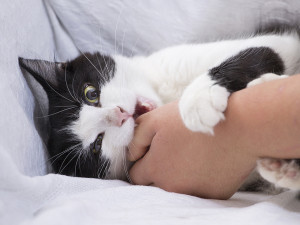TikTok’s Tinfoil Trend Isn’t Funny, It’s Potentially Dangerous For Your Cat
Discover how to safely keep your kitty from counter-surfing
Depending on your algorithm (and how chronically online you are), you may or may not have seen the viral trendopens in new tab of cats versus tinfoil. The idea behind this ‘challenge’ is that cats hate tinfoil, so if you place a sheet somewhere you don’t want your cat to go, like your countertop, it will deter your cat from jumping up.
However, the videos on TikTok show the tinfoil acting a little too effectively; causing cats to violently leap off surfaces as their paws connect with the tinfoil (or aluminium foil, or any kind of foil). As with most viral trends, the videos are prompting other cat parents to do the same and film their cat’s reaction. Now, experts are raising concerns about the safety and emotional well-being of the cats involved, so we dived into the dangers of trying this trend at home.
Get (totally free) deals for food, treats, accessories, tech and way more pet parenting must-haves.
Why are people filming their cats vs tinfoil?
“Counter-surfing cats have long been a frustration for their humans,” says trainee animal behaviourist Lottie Phillips. Whether it’s to steal food, investigate something, assert their dominance or just because they like patrolling higher ground, cats have a habit of leaping onto surfaces where they shouldn’t be.
But why foil? “Many cats appear to hate the texture and sound of the material, which deters them from jumping up,” explains Lottie of the videos, which feature cats halting mid-jump or springing back in exaggerated leaps when they touch or hear the foil. And while the idea of using tinfoil as a deterrent for cats has been floating around the internet for a long time, there are now hundreds of thousands of videos on TikTok of cats reacting to it.
Why do cats hate tinfoil?
“The aversion to tinfoil is rooted in feline sensitivity,” explains Lottie. This, combined with the fact that there is nothing like foil in the wild, makes it very strange and scary to cats. “They have no frame of reference on what exactly it is or how to deal with it.”
Sound
Cats have one of the broadest rangesopens in new tab of hearing among mammals, they can hear similar low-end sounds to us but can hear much higher-pitched sounds, up to 85 kHzopens in new tab (humans can hear up to 20 kHz). “This heightened sense of sound means that the sharp crackling sound that comes from them landing on tinfoil can startle their sensitive ears,” says Lottie. “Crinkling foil emits a very high-pitched noise, so it can sound particularly extreme to cats.”
Light
Tinfoil also reflects light in unpredictable ways, creating a visual disturbance. “There is a theory that because tinfoil is shiny and reflective like water, it may also be perceived by cats as a puddle – and most cats would avoid jumping in a pool of water if possible,” says Lottie.
Texture
Your cat’s toe beans, or paw padsopens in new tab (also known as digital pads), are highly sensitive and “they contain many nerve receptors that help them sense vibrations, pressureopens in new tab, temperatureopens in new tab and textures,” explains Lottie. So when their paws make contact with the cold, slippery surface of tinfoil, it can come as quite the shock.
What’s with the extreme reaction?
Cats’ exaggerated jumps and recoils are a result of fear and instinct, explains Lottie. “Cats are hardwired to avoid perceived threats. When they encounter something unfamiliar and unpleasant, they often react with fight-or-flight reflexes. In these cases, they’re choosing flight,” she says. While their dramatic responses may seem over the top, they’re rooted in genuine discomfort, anxiety and fear.
Are these jumps dangerous?
The big question for many viewers of the videos is whether these extreme leaps are safe for cats. When a cat jumps onto a counter expecting a stable surface, only to encounter something alarming, their reaction can be unpredictable. “They may land awkwardly, collide with nearby objects or even fall off the counter,” says Lottie. Cats are agile creatures and have a righting reflex that means they usually land on their feet when they fall, but a poorly timed jump or a hard landing could lead to injuries like sprains, fractures or head trauma.
“Beyond the physical risks, repeatedly scaring a cat with tin foil can lead to heightened stress, fear or long-term behavioural issues,” explains Lottie “A stressed cat may exhibit behaviours such as hiding, aggression or a loss of trust in their environment.”
What about the emotional impact?
“Cats thrive in environments where they feel safe and secure,” says Lottie. “Introducing a constant source of fear, like tinfoil, on a surface they regularly explore can lead to confusion and anxiety.” Over time, this stress may affect their overall well-being.
Additionally, the repeated startle effect could damage the bond between you and your feline friend. If a cat begins associating their human with fear-inducing tactics, they may become less affectionate or more withdrawn. “Cats express stress in a number of ways, including marking their environment, biting or scratching their human, hissing or hiding away,” cautions Lottie, explaining that your cat won’t realise you’re deterring them from the counter because you don’t want them up there, and will instead just create a negative association with that space, and potentially with you, too.
Safer ways to keep cats off countertops
You might be tempted to opt for this quick fix to keep your cat off unwanted surfaces, but with so much risk of both physical and emotional harm, it’s much safer for your cat to ditch the tinfoil and opt for another route.
“Starting to train your cat as a kitten is typically easier as you can discourage certain behaviours from the start, but if you have to start introducing new rules to an adult cat, it can still be done,” says Lottie. You should always avoid punishing your cat for doing something you don’t want them to, never use a spray bottle, and of course it should go without saying that you should never physically harm your cat as a punishment.
To curb unwanted behaviours, the best way to start is by thinking like a cat: “Try to understand what they are getting out of the undesired behaviour,” says Lottie. If they’re jumping up on the counter, it’s because they want something up there (usually food), are in search of a higher vantage point or they want to get involved in whatever you’re doing in the kitchen.
Provide alternative perches
Cats love to be in high places where they can survey their kingdom and feel safe, which could be the reason behind your cat’s desire to jump up on countertops. Yes, you can pick your cat up and put them on the floor every time they jump up, “but this could feel like a game to them”, explains Lottie. Instead, redirect them to new more appealing spots. Lottie suggests investing in cat perches and cat trees to satisfy their instincts. Position them near windows or areas where they can observe the action without needing to climb on counters.
Offer enrichment
“Boredom is a common reason for counter-surfing,” says Lottie. Provide toys, puzzles or interactive feeders to keep your cat mentally and physically stimulated – and to tire them out so they can snooze while you cook.
Use distraction
“Every time your cat jumps up on the counter, redirect their attention elsewhere by reaching for a toy that they can engage with on the floor, away from the counter,” says Lottie. While this might seem frustrating to have do this every time they jump up, patience is key and your cat will eventually learn that the fun is on the floor, not on the counter.
Train with positive reinforcement
“While most cats can’t be trained to the same level as dogs, it is possible for your cat to learn how to behave,” says Lottie. “Cats are often motivated by different incentives; they respond well to positive reinforcement, such as treats or play,” she explains. Reward your cat with whatever their motivator is – “a high-value treat usually does the trick” – when they stay off counters or use their designated spaces. This encourages them to choose those areas over forbidden surfaces.
Remove temptations
By keeping countertops free of food, crumbs or enticing items, you can reduce your cat’s interest in exploring them. If your cat tends to jump up while you’re cooking or preparing food, then offer them their meals at the same time to satisfy their desire for food thievery and as a way to distract them away from the counter.
While the TikTok tinfoil trend may seem funny, it absolutely comes with risks to both the physical and emotional well-being of your cat – so please don’t try it at home. By understanding your cat’s needs and instincts, you can create a safe and happy home environment without needing to resort to scare tactics.
